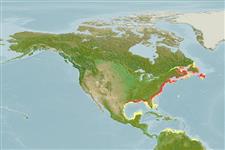Common names from other countries
分類 / Names
共通名の | 類義語 | Catalog of Fishes(部類, 種) | ITIS | CoL | WoRMS | Cloffa
Issue
Vladykov, 1955 is recognized as a valid species with constant diagnostic characters easily observable, with disjunct distribution, after it was recognized for a long time as a valid subspecies (Ref. 124040).
Environment: milieu / climate zone / depth range / distribution range
生態学
海; 新鮮な水; 汽水性の 底生の; 昇流魚 (Ref. 51243); 深さの範囲 1 - 46 m (Ref. 4639). Subtropical; 56°N - 10°S, 102°W - 33°W (Ref. 54265)
Western Atlantic: Hamilton River, Labrador, Newfoundland, Canada to northeastern Florida, USA. Occurs occasionally in Bermuda and French Guiana (Ref. 7251). Northern Gulf of Mexico (Ref. 26938). In Europe: Baltic Sea. Landlocked populations in Lakes Ladoga and Onega (Russia), both now extirpated. Occasionally recorded from Great Britain and North Sea in Elbe drainage (Ref. 59043). Recent research revealed that this species existed in the Baltic Sea, but is now extirpated (Ref. 83384, 83385). Near threatened globally, but extirpated in Europe (Ref. 59043).
Length at first maturity / サイズ / 重さ / 年齢
Maturity: Lm 201.7, range 183 - 243.8 cm
Max length : 403 cm TL オス/雌雄の選別がない; (Ref. 26938); 430.0 cm TL (female); common length :250 cm TL (female); 最大公表体重: 0.00 g; 最大記録サイズ: 60 年 (Ref. 39404)
簡単な記述
検索表 | 形態学 | 形態計測学
背面の脊椎 (合計) : 0; 背鰭 (合計) : 30 - 46; 肛門の骨: 0; 臀鰭: 22 - 32. Elongate fish, pentagonal in cross section and shark-like fins (Ref. 26938). Double row of pre anal shields. Presence of a soft fontanelle. Bony shields are oval. Carina on dorsal shields do not have a conspicuous hook. Head and back bluish-black and lower surface whitish (Ref. 37032). Snout long, sharply V-shaped. 2 pairs of short, slender barbels in transverse line midway between end of snout and anterior edge of mouth (Ref. 4639). Viscera pale (Ref. 7251). Presence of 4 small scutes, usually as 2 pairs between anal fin and caudal fulcrum (Ref. 86798).
Anadromous species. Occurs solitarily or in small groups; inhabits shallow waters of continental shelves. At the sea, it occurs in coastal and estuarine areas on soft bottom (Ref. 59043) down to a depth of 50 m (Ref. 89115). Adults are highly migratory while at sea (Ref. 57533) and make long migrations along the coast (Ref. 59043). Feeds on benthhic invertebrates such as mollusks, crustaceans and aquitic insects from the sediments (Ref. 93252). They forage mainly in brackish waters (Ref. 59043). Ascend large rivers to spawn (Ref. 59043). Juveniles may remain in fresh or brackish water until 2-5 years of age or 76-91.5 cm long (Ref. 4639, 59043). Today most individuals do not exceed 250 cm length. Tagging studies have shown that this species may move distances up to 1,450 km (Ref. 89119). Used smoked and fresh (Ref. 37032). Near threatened globally, but extirpated in Europe due to massive overfishing, damming, river regulation and pollution (Ref. 59043).
Matures at increasing ages with increasing latitude (Ref. 88171). Both sexes do not spawn yearly and spawning intervals may vary according to area. In the St. Lawrence River, males spawn every 1-5 years, females every 3-5 years (Ref. 89103). Adults from the sea begin to ascend the lower reaches of large rivers in spring with the majority ascending immediately prior to spawning. Spawning occurs between March and August (Ref. 59043), when water temperature is 13.3-17.8 °C (Ref. 89118). Spawning occurs over bedrock, boulders or gravel bottoms, in depths exceeding 10 m at current velocities of 0.5-0.8 m/s (Ref. 59043, 89103). Exact time of spawning depends on temperature (Ref. 26938). Per female 0.4-8 million eggs may be spawned (Ref. 45706, 84845, 89137). Eggs demersal, sticking to stones, measuring 2.55 mm in diameter and hatching in 1 week at 17.8 °C (Ref. 4639, 9980). Adults return to the sea after spawning (Ref. 59043). Sturgeons in general have a high capacity for hybridization and most species are able to cross-breed (Ref. 89103, 89117).
Page, L.M. and B.M. Burr, 1991. A field guide to freshwater fishes of North America north of Mexico. Houghton Mifflin Company, Boston. 432 p. (Ref. 5723)
Human uses
水産業: 商業
用具
特記事項
XMLをダウンロードして下さい
インターネットの情報源
Estimates based on models
Preferred temperature (Ref.
115969): 4.3 - 24.4, mean 17.3 (based on 268 cells).
Phylogenetic diversity index (Ref.
82804): PD
50 = 0.5000 [Uniqueness, from 0.5 = low to 2.0 = high].
Bayesian length-weight: a=0.00324 (0.00142 - 0.00736), b=3.17 (2.99 - 3.35), in cm Total Length, based on LWR estimates for this Genus-body shape (Ref.
93245).
栄養段階 (Ref.
69278): 3.4 ±0.50 se; based on food items.
回復力 (Ref.
120179): 非常に低い, 14年以上の倍増期間の最小個体群 (K=0.03; tm=7-34; tmax=60; Fec=1.03 million).
Fishing Vulnerability (Ref.
59153): Very high vulnerability (85 of 100).
